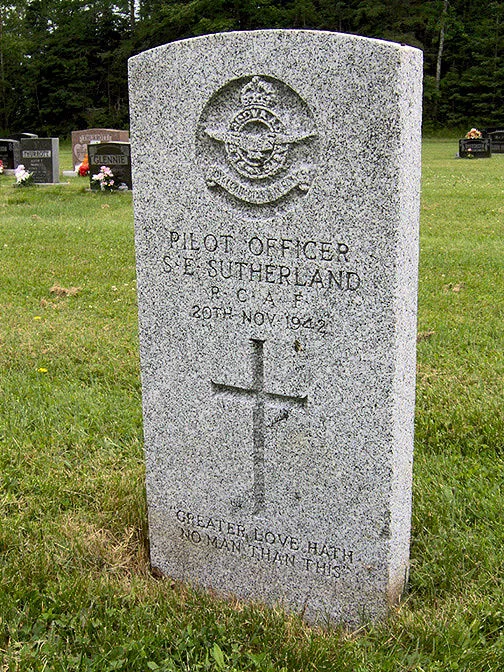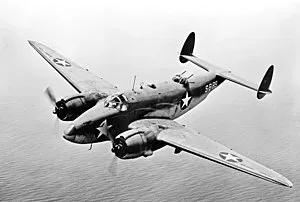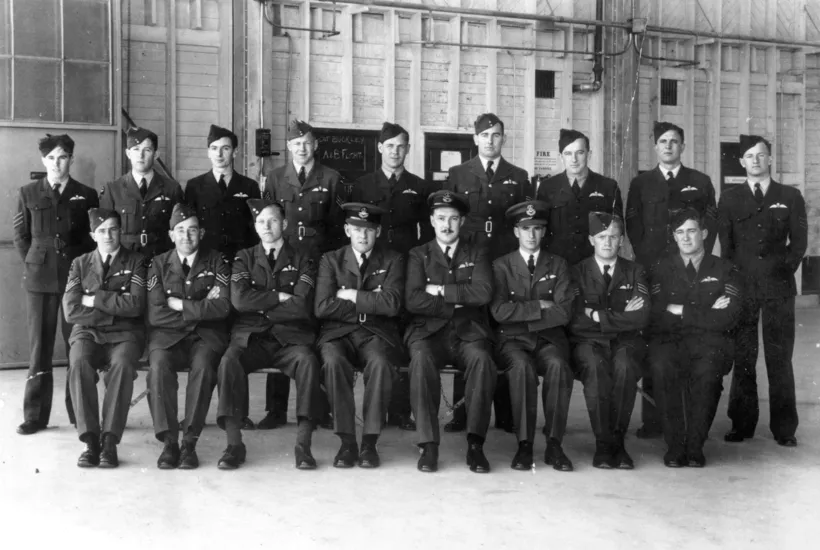Sutherland, Stanley Evan (Pilot Officer)
Killed in Flying Accident 1942-November-20


Birth Date: 1921-January-08
Born:
Parents: Son of George R. Sutherland and Carletta Ellis Sutherland, of Brookfield, Nova Scotia.
Spouse: Husband of Gwenn M. Sutherland, of Brookfield, Nova Scotia.
Home: Brookfield, Nova Scotia
Enlistment:
Enlistment Date: unkown date
Service
RCAF
Unit
34 OTU- Operational Training Unit (RAF)
Base
Pennfield Ridge, New Brunswick, Canada
Rank
Pilot Officer
Position
Wireless Air Gunner
Service Numbers
J/15455
Crew or Other Personnel
Ventura AE932
Accident Card - Lockheed Ventura Mk. II serial:AE932
This accident involved 1 aircraft on 1942-November-20. Ventura II s/n AE932.
This accident involved 3 people. Male HO, Sergeant TF, Sutherland SE
This accident had 3 fatalities. Pilot Officer Stanley Evan Sutherland RCAF Killed in Flying Accident service no:J/15455 Ventura AE932, Aircraftman 1st Class Thomas Frederick Sargeant RAF Killed in Flying Accident service no:1125256 Ventura AE932, Pilot Officer Harold Otho Male RAFVR Killed in Flying Accident service no:188825 Ventura AE932
Ventura serial: AE932

A Lockheed PV-1 Ventura
The Lockheed Ventura is a twin-engine medium bomber and patrol bomber of World War II.
The Ventura first entered combat in Europe as a bomber with the RAF in late 1942. Designated PV-1 by the United States Navy (US Navy), it entered combat in 1943 in the Pacific. The bomber was also used by the United States Army Air Forces (USAAF), which designated it the Lockheed B-34 (Lexington) and B-37 as a trainer. British Commonwealth forces also used it in several guises, including antishipping and antisubmarine search and attack.
The Ventura was developed from the Lockheed Model 18 Lodestar transport, as a replacement for the Lockheed Hudson bombers then in service with the Royal Air Force. Used in daylight attacks against occupied Europe, they proved to have weaknesses and were removed from bomber duty and some used for patrols by Coastal Command.
At the start of the war, Lockheed proposed military conversions of the Lodestar for the RAF as replacement for the Hudson reconnaissance aircraft and the Bristol Blenheim bomber. The first British order was placed in February 1940 for 25 Model 32 as bombers. This was followed by an order for 300 Model 37 with Double Wasp engines, then for a further 375 later in 1940. Lockheed needed more production capacity and nearby Vega Aircraft Corporation was contracted for building the Ventura.
The Ventura was very similar to its predecessor, the Lockheed Hudson. The primary difference was not in layout; rather, the Ventura was larger, heavier, and used more powerful engines than the Hudson. The RAF ordered 188 Venturas in February 1940, which were delivered from mid-1942. Venturas were initially used for daylight raids on occupied Europe but, like some other RAF bombers, they proved too vulnerable without fighter escort, which was difficult to provide for long-range missions. Venturas were replaced by the faster de Havilland Mosquito. The Venturas were transferred to patrol duties with Coastal Command as the Mosquito replaced them in bomber squadrons; 30 went to the Royal Canadian Air Force (RCAF) and some to the South African Air Force (SAAF). The RAF placed an order for 487 Ventura Mark IIs but many of these were diverted to the USAAF, which placed its own order for 200 Ventura Mark IIA as the B-34 Lexington, later renamed RB-34.
A total of 157 Ventura G.R. Mk. Vs were used operationally by the RCAF from 16 June 1942 to 18 April 1947 in the home defence coastal patrol role in both Eastern and Western Air Command. They were flown by 8, 113, 115, 145, and 149 Squadrons. A further 21 Ventura Mk. Is and 108 Ventura Mk. IIs were used in a training role at 1 Central Flying School, Trenton, Ontario, and at RCAF Station Pennfield Ridge, New Brunswick (RAF No. 34 Operational Training Unit) as part of the BCATP. A total of 21 Mk. Is, 108 Mk. IIs, and 157 G.R. Mk. Vs were in service during this period for a total of 286 aircraft. Wikipedia
Aircraft Images
Ventura AE932
Ventura Mk. II AE932
Assigned to No. 34 OTU at Pennfield Ridge, NB. Suffered a Cat "A" crash. On 20 Nov 1942 P/O. Male, the pilot, had been detailed to fly AE932 to Dartmouth and collect certain freight. P/O. S.E Sutherland was the wireless operator and Acting Flight Sergeant .F. Flight, an engine mechanic, was one of three passengers also made the trip to Dartmouth. The a/c arrived at Dartmouth at 1640 hrs. Two of the passengers remained there and at 1740 hrs the a/c took off on its return journey. The fatal flight was en route from Dartmouth Nova Scotia to RCAF Station Yarmouth when it crashed 4 miles north-east of Caledonia, Queens Co, NS at 2130 hrs. The plane was carrying hydraulic oil from Dartmouth to Yarmouth. At the time of take-off there was a ceiling of 500 ft with a visibility of 3 to 4 miles and moderated rain. At the time of crash, there was drizzle rain and low clouds and a visibility of 4 to 5 miles. Messages had been received from the a/c at 1803 hrs. and 1823 hrs. The last message was to the effect that the pilot had nothing to communicate. No difficulty whatsoever was had in exchanging signals with the a/c. At 1828 hrs. the signals officer at base called the aircraft to tell the pilot he had a message for him, there was no reply. At 1830 hrs. the signals officer asked pilot for his estimated time of arrival and received no acknowledgement, and calls were continued until 1940 hrs., but with no reply. Then word came that the a/c had crashed. Residents of the districts of Westfield and Caledonia in Queens County, NS heard the aircraft at about 1820 hrs. as it flew in a south-westerly direction. About 3 minutes later the aircraft was heard circling from the south east to north-east; then at about 1825 hrs. the sound of the engines ceased and within a minute there was a large flash of light followed by a loud explosion. The a/c was totally destroyed and the occupants were killed instantaneously. An examination of the wreckage by the BOI disclosed that the a/c was in a steep left hand turn and losing height, when it struck the top of the trees. That the a/c was approaching the ground at an angle of 45°. circling at a low altitude in conditions of poor visibility the a/c struck trees with the port wing tip and crashed. There were no indications of structural failures in flight. The investigation. further stated: "The aircraft was so badly wrecked and scattered that it was impossible to make any observations on the instruments, flying controls, engine controls or fuel tanks. Male, Sutherland and Flight were all killed in the crash. The wreckage was salvaged by No. 4 Repair Depot for scrapping on 24 Nov 1942.1942-08-12 Taken on Strength Eastern Air Command 2019-08-20
1942-November-20 Accident: 34 Operational Training Unit Loc: Caledonia Nova Scotia Names: Male | Sergeant | Sutherland
1943-02-16 Struck off Strength Struck off, reduced to spares and produce 2019-08-20
Unit Desciption
34 OTU (34 Operational Training Unit)
The Operational Training Unit (OTU) was the last stop for aircrew trainees. They spent 8 to 14 weeks learning to fly operational aircraft (Hawker Hurricane or Fairey Swordfish, e.g.). The instructors had experience in actual operations, and often were posted to OTUs after their operational tour.
No.34 Operational Training Unit (RAF), consisting of approximately 55 Officers and 700 airmen, was sent to Canada from Gourock, Scotland on 08 April 1942 aboard the RAF Transport M/S Batory. Arriving in Halifax Harbour 16 April 1942, then put aboard a troop train to Yarmouth, NS arriving the following morning around 0800 hours. Marching into camp, which was still incomplete, they discovered no plumbing, no water, no heat and muddy roads.
Over the next three or four weeks was to be a time of roll calls, fatigues and route marches, as they had no planes and nothing constructive to do. Soon they learned a decision had been made to move the Unit to Pennfield Ridge, NB on a "temporary" bases - the move completed in three stages between May 18 and May 27, 1942.
Here at Pennfiled Ridge aircraft and aircrews started to arrive and the Unit began to do the job it was organized for - bring the four members of the aircrew (Pilot, Navigator, Wireless Air Gunner and Air Gunner) together for the first time to train as a crew in an operational training setting. Upon graduation most crews were sent overseas to Battle Squadron. The first course commenced on 08 June 1942.
On 31 August 1942 it was decided to retain the Unit at Pennfield Ridge and detach the Armament Training Wing to Yarmouth. Therefore about 250 airmen were shipped back to Yarmouth taking over Hangars No.1 & No.2 one for in-flight training and one for maintenance. The first nine courses at Pennfield Ridge received their armament training at Yarmouth before returning back to Pennfield Ridge for graduation.
Pennfield Ridge became inactive effective 30 April 1944 and disbanded effective 19 May 1944; All training, upon graduation of trainees on 30 April, was ceased. All personnel, except maintaining sufficient personnel to hand over buildings and equipment of the Unit to the Commanding Officer of RCAF Station, Pennfield Ridge, was to take place between 30 April and 19 May, 1944. Summary provided by G. Christian Larsen
Project 44 BCATP
